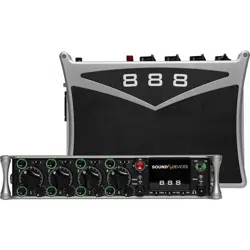Loading ...
Loading ...
Loading ...

888 User Guide
41
Glossary
¼-inch jack
Common analog audio connector used as both an audio input and
output. When a ¼-inch jack is described as TRS (tip-ring-sleeve) it
can be wired as either a balanced connection or as a two-channel
connection. ¼-inch headphone jacks are typically wired as TRS stereo
jacks.
3.5 mm jack
Common small-format audio connector. Often used for headphones
and -10 dBV signals for portable audio devices.
AES3
A standard for the exchange of digital audio signals between
professional audio devices. An AES3 signal can carry two channels of
PCM audio over balanced, 110 ohm interconnections. AES3 is most
commonly interconnected with XLR-3 cables.
AES42
A digital interface protocol for microphones and microphone inputs.
Microphones conforming to this standard directly output digital audio
through an XLR or XLD male connector, rather than producing an
analog output. AES42 microphones require powering.
Attenuation
A reduction in the level of an audio signal. Attenuation can be
applied to both analog and digital signals. A fader is used primarily
to attenuate signals, though a small amount of positive gain is often
available on a fader.
Bext chunk
Broadcast WAV extension data added to the audio data in a WAV le.
The bext chunk includes timecode and user bit data. For systems that
do not recognize the bext chunk this additional information is ignored.
Bit depth
When converting between analog and PCM digital audio the
amplitude of an analog signal is measured in nite steps, measured
in bits. Higher bit rates result in greater resolution of amplitudes,
resulting in higher dynamic range. 24-bit audio, with a theoretical
maximum dynamic range of 144 dB, is the standard bit depth used
throughout the audio chain for production.
Broadcast WAV, BWAV
Broadcast WAV les are WAV les with additional, non-audio data,
such as bEXT chunk data. Broadcast WAV les offer timecode
support.
Bus
An audio path that is the destination of one or multiple (mixed)
channels. A bus is typically routed to an output, a record track, or
both.
Camera return
An audio input on a mixer designed to receive the output, typically the
headphone output, of a camera. Camera return inputs allow the user
to monitor the level and quality of the signal received at the camera.
On the 888, the camera returns can be used as a source for any
channel.
Channel
A “slot” of a mixer that is controllable and routable. A given input
feeds the channel and the channel’s settings process and route the
audio as required. It can also be thought of as the path its selected
input signal takes on its way to its record track, a bus, or an output.
Channel grouping
With the 888, any of the 16 channels can be grouped together so
that their faders, record arming state mute states can be controlled
together. Channel grouping can be used as an alternative to sending
channels to a bus.
Circled take
An identifying character, the @ symbol, which is placed in the le
name to highlight a take. Circled takes can either be used to identify
good takes or to identify tracks or takes that will be ignored.
Com return
A dedicated audio input designed to receive signals from a PL, or
private line communications circuit. The com return on the 888 can
routed to an output or a bus.
Com send
A dedicated output designed to send signal to a PL (private line,
talkback) communications circuit. The com send is toggled by a front
panel switch.
Dante
A combination of software, hardware, and network protocols that
deliver uncompressed, multi-channel, low-latency digital audio over a
standard Ethernet network using Layer 3 IP packets.
dBFS
A measurement of the signal level of a digital signal in dB increments,
dB relative to full scale signal. The maximum signal in dBFS is 0
dBFS, with signals expressed with a negative sign. dBFS signal
strength is an internal measurement and does not correspond to
analog signals unless the relationship between analog signal and
digital signal is known.
Delay (channel)
Time delay that can be applied to an individual channel. Channel
delay, typically set in milliseconds, is often used to compensate for
different acoustical or electrical arrival times of signals between
channels.
Loading ...
Loading ...
Loading ...
